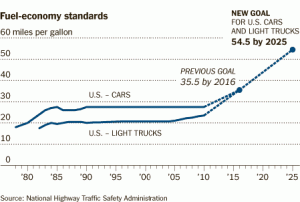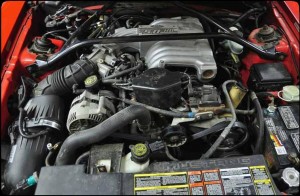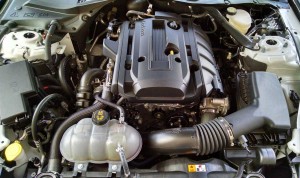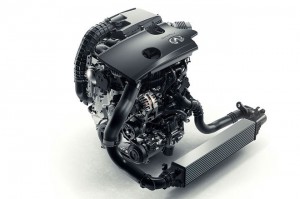Engines are getting smaller again – but not because gas is getting expensive again. At about $2 per gallon for regular unleaded, the pressure to downsize engines isn’t economic… it’s regulatory.
The federal government is about to kick up the Corporate Average Fuel Economy (CAFE) requirement to 54.5 MPG. The current standard is 35.5 MPG. This is the “mandatory minimum” each car company’s fleet (all of its passenger cars and light trucks taken together) must average. If the average falls below the mandatory minimum, the government imposes “gas guzzler” fines, which are passed on to buyers in the form of higher prices.
CAFE has been around a long time – since the ’70s – but what’s different now vs. in the past is that engineering advances are making it feasible to downsize engines in order to burn less fuel and make the CAFE cut without also downsizing power and performance.
Currently available four cylinder engines around 2.0 liters in size, fitted with high-efficiency (and high boost) turbochargers produce more than 200 hp; a few of them more than 300 hp. These are strong numbers – comparable to the horsepower made by much larger V6 and even V8 engines of the not-so-distant past.
For example, a 1995 Ford Mustang GT with a 5.0 liter V8 had 215 hp and got 17 MPG in city driving and 25 MPG on the highway. A new (2016) Mustang can be ordered with a 2.3 liter turbocharged four that makes 310 hp – almost 100 hp more than the ’95 Mustang’s 5.0 V8 – out of an engine half the size. The “EcoBoost” four cylinder in the new Mustang also gets better mileage than the old (and much less potent) V8: 22 city, 31 highway.
Here’s another – even smaller:
The 2016 Mini Cooper comes standard with a 1.5 liter three cylinder engine – also turbo’d. It produces 134 hp, enough power to get the Mini to 60 in about 7.4 seconds. EPA says it’s also good for 29 MPG in city driving and 39 MPG on the highway.
For contrast, a ’95 Geo Metro with a three cylinder engine (no turbo) made 55 hp and took almost twice as long (13.7 seconds) to get to 60. It did achieve a spectacular 44 MPG in city driving and 49 MPG on the highway – better than the new Mini’s three – but the chief reason for that was the Metro’s much lower curb weight: 1,808 lbs. vs. 2,605 lbs. for the new Mini.
If the ’16 Mini weighed as little as the ’95 Geo, it would almost certainly at least match the Metro’s MPGs while being even quicker than it already is.
And, there’s more coming – in spite of the government’s Very Tall Order (54.5 MPG on average, just nine model years from now).
Nissan has a variable compression 2.0 liter four cylinder engine in the works which will – so Nissan says – equal the mileage of current diesel (and hybrid) powertrains without the cost or complexity of either while also delivering very high output of both torque and horsepower.
This could resolve an ancient Catch-22 that engineers have been wrestling with since literally the dawn of internal combustion more than 100 years ago.
High compression in a gas-burning engine is good for power and efficiency, but it also creates more heat and pressure, which typically requires high-octane fuel to forestall engine knock due to uncontrolled/premature ignition inside the cylinder caused by the high heat; the fuel auto-ignites instead of being ignited in a controlled fashion – and at the right moment – by the spark plug.
Lower compression lowers the octane requirement and reduces the problem of engine knock, but isn’t optimal for power or efficiency.
Engineers had to pick a fixed ratio – usually, a compromise ratio – which was determined mechanically (and permanently) by such things as the shape of the piston top or the size of the combustion chamber in the cylinder head.
Nissan’s VC-T engine, which will debut next month at the Paris Auto Show, uses an adjustable lever (in simple terms) between the crankshaft and the connecting rod – which is what the piston is connected to as it travels up and down within the cylinder. Compression can be increased or decreased at will – according to the demand on the engine – by changing the geometry of the lever, which in turn increases or reduces the travel of the piston within the cylinder. If it travels higher in the cylinder, the air-fuel mixture is squeezed harder (higher compression). If it travels less high, the compression is reduced.
Nissan says the VC-T engine can automatically adjust from as low as 8:1 compression to as high as 14:1.
This improves fuel economy by almost 30 percent over the company’s 3.5 liter V6 engine, while also producing about the same horsepower and torque.
The 3.5 liter V6, which is used in many currently available Nissan (and Infiniti) cars, makes about 300 hp and delivers about 21 MPG in city driving and 30 on the highway (in the Maxima sedan, used as an example). If the VC-T delivers the goods, highway mileage should approach 40 – safely above the current 35.5 MPG mandatory minimum laid down by CAFE – without any loss of performance.
Performance may even increase – because a 2.0 liter four cylinder engine weighs significantly less than a 3.5 liter V6. If the power produced by the VC-T engine is about the same as the power produced by the 3.5 liter V6 but the car weighs less because there is less engine under the hood, the car should be even quicker than it was with the V6.
Nissan says the new VC-T engine will go into production next year.
All of this shows that in spite of the government’s best efforts to suck the power (and fun) out of cars, resourceful engineers are – so far – more than a match for regulatory bureaucrats.
EPautos.com depends on you to keep the wheels turning! The control freaks (Clovers) hate us. Goo-guhl blackballed us.
Will you help us?
EPautos stickers – new design, larger and magnetic! – are free to those who send in $10 or more to support the site.
Our donate button is here.
If you prefer not to use PayPal, our mailing address is:
EPautos
721 Hummingbird Lane SE
Copper Hill, VA 24079











I’m just concerned with the longevity of any turbo, since I’ve never had a turbo last the 150,000-200,000 miles I’ve put on naturally-aspirated gasoline engines, without a major repair.
Well, we’ll have our answer within the next few years.
Personally I believe leasing (turning it back in while everything’s still under warranty) will become even more popular…
My TDI had 207k on it when the trans went out, no problems w/engine.
Considering the longevity of turbos on trucks, I don’t think it’s an issue of the turbo itself, as long as it gets proper maintenance. Although I still wonder what long-term ULSD may have.
If anything, low sulphur should be a boon. I don’t see that large of an increase of cylinder temp using ULSD but more of a lubrication thing of the cylinder wall/piston rings.
The main thing about turbos is what sort of life they are built to withstand. Diesel equipment turbos are built to be run WOT at any ambient temperature and not such great oil cooling because of dirty coolers you expect.
Just last week a friend told me he solved his overheating problem, it was his intercooler being full of crud, mainly powdered limestone and dirt. I always clean my intercooler when the view calls for it. He hadn’t thought about it and his engine kept overheating to the point he’d have to flip the over-ride switch, a bad thing. Once all the coolers were clean his temp went down and wouldn’t even get above it’s normal operating temp.
Do car makers design their turbos to live with a great deal of WOT? Do they consider coolers getting dirty and oil temps getting higher? I can guarantee you harder use on things like smaller engines, even smaller diesels like Cummins in fairly large light trucks can damage a turbo.
The company I worked for had a lot of Dodge light trucks up to the 5500 series with a Cummins engine and the ones from 2012 and newer had overheating problems in hot weather at 75mph with big trailers and not even big loads. I had a hotshot load of about 5,000 lbs or less on a 32′ trailer one day going uphill every step of the way for 200 miles and kept having to slow down for 15-20 miles to let the engine cool. The main boss asked me when I got to the terminal if I had any problems. I said Yeah, a minor one. He said It overheated. That was SOP and he said he was about to change to another brand since so many of them did that. I don’t know what they did on those model trucks but that wasn’t a problem on the prior years.
I suspect some people not only drive a car much harder all the time but live in an area like mine where most of the year is really hot. It all goes back to saving money and the EPA pushes the makers to use less oil in vehicles so that’s another factor. Even humidity affects how well an air cooler works so hot and humid as worse than hot and dry.
Not sure if it is still the case, but I remember the dealership I worked for in high school would have turbos rebuilt at a local truck place. It was pretty cheap.
I’m way more concerned with having to deal with the effects of DI.
You know, I’ve read the entire Constitution and all the Amendments several times, and I can’t find anyplace where Congress — or its dirty-work surrogates, the EPA — have any right to demand any such thing. Has anyone else spotted it? Maybe it’s just me…..
No Treason, the Constitution of No Authority, Lysander Spooner
But Brother John, haven’t you heard? The Constitution is a “living” document! The “general welfare” and all…
I thought it was “just a goddamn piece of paper” to them….?
Rules for thee, but not for me.
Douse them in butane and light a match.
The EPA and most of the other 400+ federal agencies eating out our substance are based primarily on the Supreme Court’s radical expansion of the Interstate Commerce clause.
Originally intended to prevent trade wars between the states, the high court decided that anything which might even theoretically affect interstate commerce falls under its umbrella. If you so much as flick a booger in the general direction of the state line, as far as any number of agencies are concerned you are under their jurisdiction.
Of course the Supreme Court was never granted the authority to make law by interpreting the Constitution in this way. It’s a power that John Marshall basically pulled out of his ass and it stuck, like a dingleberry on the body politic.
http://libertyworksradionetwork.com/jml/images/stories/pdfs/Courts_booklet.pdf
“Of course the Supreme Court was never granted the authority to make law by interpreting the Constitution”
Very true, in fact that’s what the 9th and 10th Amendments are about, it is up to the States to decide what powers they had or had not ceded to the Central Gunvermin.
See also the Kentucky and Virginia Resolutions of 1788-1789 by Jefferson and Madison.
Re: VC-T
Since all new engines are moving to Direct Injection, this seems an overly complicated way of varying compression that would weaken the bottom end. Wouldn’t it just be easier to delay when the exhaust valve closes in order to bleed off some cylinder volume, thereby lowering the compression? Could even use a fifth valve specifically for the task.
I’m not much of a engine specialist so maybe I am missing something?
Saab had a prototype variable compression engine 15-16 years ago, but it never reached production. (The project was axed due to cost when GM took over the company.) It used a hinged, two-piece block to effectively raise and lower the cylinder head to vary the compression ratio.
https://en.wikipedia.org/wiki/Saab_Variable_Compression_engine
VW did that on the W engine, didn’t last long.
I think it’ll be weak too. In the current design, during the compression stroke, the force of the expanding gas is pressed against the bearings in the connecting rod. Nissan’s design will transfer a fair amount of that force to their adjustable linkage. Hopefully it’ll have bearings as strong as those in the connecting rod. Plus — more to wear.
“If the ’16 Mini weighed as little as the ’95 Geo, it would almost certainly at least match the Metro’s MPGs while being even quicker than it already is.”
A 2000 lb Mini could be fitted with a smaller, non-turbo engine that would exceed the Metro’s mileage and retain its already outstanding performance. I would hope a lighter Mini could retain current performance characteristics without sacrificing overall quality.
The Suzuki based Sprint/Metro was the chinziest vehicle I had ever driven, dispite the great fuel economy and reliability. I know what the fledgling chick feels like after escaping the egg. Even the cheapest Rambler was luxurious by comparison.
Sure, but driving those fragile little beasts sure sharpens your situational awareness!
The problem comes in when the regulators and politicians then claim to have granted the people the wonderful new technology. People get this idea that all good things flow from the state.
Furthermore the regulators and politicians, the ones who aren’t trying to regulate the automobile back into a rich man’s toy, then feel they can demand more. Those that are anti-private passenger automobile will also want to go further because they didn’t succeed.
The simple fact is if people demanded fuel economy or power or anything else and voted with their money they would get it.
As an engineer I find this fascinating. I do have to question the long-term reliability of this system though…looks like there will be all kinds of new forces acting on the crank. As an enthusiast, however, I’m not so excited. I guess the writing is on the wall for V8s and even V6s. I better buy my 60s/70s muscle while it’s still legal (Anyone know of a killer deal on a solid Polara, Monaco, or Satellite?).
Shemp, you might be right in staying with old school. I’m sure you’re aware of the efficiency of compression ratios in an engine and how virtually any ratio between 8 and 14 has its advantages. Somewhere I have chart of the efficiency of everything between those two points and will look it up when I have time and post it.
Infiniti has taken that chart and made an engine that uses the entire range. Its efficiency shouldn’t be doubted. It will most likely do a great job but how long it will last is another aspect. Just as you’d suspect it comes with more complications and no doubt, less durability(the durability claim or lack thereof is mine). The engine will sell and continue to sell based on durability no doubt.
Like any other thing, the more complex it is, the more things can go wrong. Sure, the first big breath I take upon waking could set a chain of things in motion so that the coffee starts brewing, the breakfast of choice, maybe even changing on how large the breath is, will begin cooking and the Cherry 2000 will make sure your day starts off just right. Just don’t hold your breath that it will happen easily or cheaply or continue to work day in day out.
http://gizmag.us1.list-manage.com/track/click?u=57c04fd0f2defe64b0f583dc7&id=433f94d3d5&e=b89acd4700
I would think that building the motor with a tight quench at 8:1 SCR and controlling the effective compression by varying boost pressure would work without the extra mechanical complexity and potentially undesireable excessive quench (more prone to knock) when in lower compression modes…..
It would seem to me variable pitch turbo blades plus twin scrolls or maybe three could do almost the same thing with less complexity. After all, twin scroll turbos merely operate by splitting the exhaust manifold for half the engine. Some big diesels have twin turbos inline which effectively changes the CR ratio too. Twin scroll turbos with twin exhausts going to another twin scroll turbo would be a bit more complicated but probably last longer than all those reciprocating pieces.